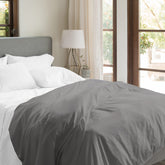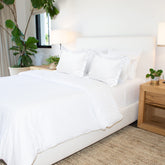Your bedroom should be your sanctuary – the space where you feel most comfortable, calm, and relaxed. After all, you spend roughly one third of your life in your bedroom, whether you’re sleeping 6-8 hours every night, spending time dressing and undressing, watching Netflix, surfing the web, reading a book, or just lounging. Getting quality sleep is also essential to maintaining your health and quality of life.
However, all of this is easier said than done if you’re an allergy sufferer. After all, how are you supposed to feel calm and peaceful when you’re battling endless sneezing, coughing, and watery eyes? There aren’t many things more frustrating than not being able to sleep because you’re itching, wheezing, or suffering from congestion or a runny nose. Unfortunately, the bedroom can be one of the biggest problem areas for allergies, thanks to dust mites, mold, pet hair, and other nasty allergens.
The good news is that you don’t have to continue to sleep in misery! There may not be a simple cure for asthma or allergies, but there are some simple things you can do to remove allergens from your environment. The more of these that you can eliminate, the fewer symptoms you’ll have to deal with. And, since you spend so much time in your bedroom, it really pays to make it an allergy-free zone.
First things first…
What causes allergies?
Some of the biggest culprits when it comes to allergies are irritants like pollen, dust mites, mold, and pet dander. These can be made worse by poor air quality and ventilation and high humidity. If you’re not sure what exactly is causing your symptoms, you may want to get an allergy test that can help to identify your specific triggers.
What are the most common allergy symptoms?
Allergy sufferers experience a range of symptoms at various levels of severity, but the most common include:
- Sneezing
- Runny or stuffy nose
- Red, itchy, or watery eyes
- Coughing or shortness of breath
- Itching
So now that we’ve laid out some of the root causes and issues to consider, what can you do to allergy-proof your bedroom? Here are the tips and strategies we recommend that you follow.
Purify the Air
An air purifier is a great investment for allergy sufferers as it will improve the quality of your bedroom air by capturing impurities such as pet dander, dust, and pollen, and then circulating clean air into the room. Allergists recommend an air purifier with a HEPA filter (a multi-layered filter that is airtight and can filter even ultra-fine particles). You should also look for products with an AHAM (Association of Home Appliance Manufacturers) certification. AHAM also recommends that the CADR (Clean Air Delivery Rate) of your air purifier should be equal to at least two-thirds of the room’s area. To keep your air purifier working properly, make sure to change your filters regularly.
Take Steps to Control Mold
If mold is an issue in your bedroom, it’s a good idea to monitor and control the humidity by using a dehumidifier. In fact, even if mold isn’t an issue for you, it’s worth noting that dust mites also love warm, moist environments. Dust mite waste is one of the most common allergens present inside the home, so a dehumidifier can help with this too. To prevent mold and reduce the multiplication of dust mites, you’re advised to try and maintain your home at a temperature between 68 F and 72 F, with a relative humidity no higher than 50%. A dehumidifier can certainly help with that, but you also want to ensure that your air conditioning system is working properly and you are changing the filters regularly.
Vacuum Often
Vacuum often – at least once a week –if your bedroom is carpeted. It may also be worth considering switching to hardwood floors if possible. Again, choosing a vacuum with a HEPA-certified filter is ideal. Remember, a vacuum without an effective filtration system is little more than a dust blower! Be sure to wear a face mask while you vacuum to prevent you inhaling all those allergens as they’re displaced.
Prevent Dust
Prevent dust build-up by keeping your bedroom clutter-free. This can also include limiting how many accessories are on dressers and nightstands that can collect dust. Drapes and window treatments can also be dust traps, so consider replacing them with blinds that are easy to clean.
Pets
We love our cats and dogs, but pet dander is another very common allergen. Dust mites feed off of pet dander, which can exacerbate the problem. But don’t worry – if you’re a pet owner and lover, that’s not to say you shouldn’t have pets! But you may need to enforce an off-the-bed policy in order to minimize pet dander. If your allergies are severe, you may even have to consider a no-bedroom rule for your furry friends.
Fresh Air
Depending on your region and climate, throwing open the doors and the windows once in a while can be a good thing. It allows fresh air to circulate throughout your house and helps usher out some of that stale air. If it’s high pollen season though, it might be best to leave the doors and windows shut and just let your home’s air filtration system do its work.
Greenery
Succulents are another great option to consider for your bedroom because they offer a pollen-free way of decorating, and they’ll generate some fresh oxygen for you, too.
Allergy-Proof Bedding
You’ll be amazed at the difference switching to hypoallergenic bedding can make to your life! Allergists recommend that you protect your bedding by encasing your pillows, mattress, and box spring with zippered, hypoallergenic, dust-mite-proof covers.
Another step you can take is to wash your bed sheets, pillowcases, and blankets or duvet covers often (once a week is a good rule of thumb). You don’t have to wash other bedding as often, but you should make sure you’re cleaning them regularly. Lastly, replace any down bedding with hypoallergenic materials, such as a good microfiber. Microfiber is known to be hypoallergenic and dust mite preventative.
Best Bedding for Allergies by Jennifer Adams
If you’re in the market for new bed sheets, check out our premium brushed microfiber Lux Collection from Jennifer Adams. Found in 5-star luxury hotels and resorts, and with over a million sold worldwide, these Lux Collection sheets are unparalleled in terms of softness, comfort, ease of care, and allergy-friendly performance. The Lux Collection from Jennifer Adams also includes duvet covers, coverlets, and blankets like our Amelia quilted set or our Salerno set, and other bedding too.
Follow these tips, and you’re sure to breathe a little easier and sleep much better in no time!






